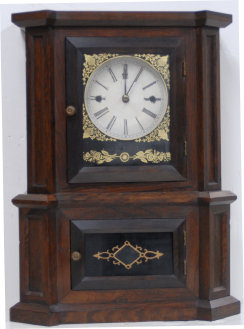
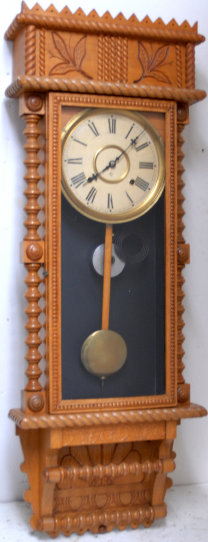
23. $275
Waterbury Clock Company hanging clock, “Alton”, ca 1906. Walnut case is clean but covered with an old crazed finish and the appearance of a coat of shellac on the wood that has never been touched. The case is almost 40” tall, has ripple molding all around the door frame, applied carvings or pressed trim pieces on the top and base, grooved decorations around the sides. Two partial labels on the back, a complete black label inside, and a correct brass pendulum bob. It is a Waterbury trademark bob with circle in the center, also has a signed beat scale, signed original dial, winding key, correct gong and gong base, and a good old glass in the door. The 8-day movement is signed and is running and striking correctly. There are no extra holes around the movement or dial pan. This is a good original, straight clock. Ly-Waterbury #602. $300-$500.
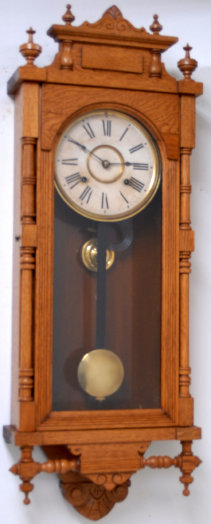
24. $250
Ansonia Clock Co. hanging clock, “Queen Elizabeth”, ca 1901. The oak case is 37” high, has been restored by cleaning and polishing the original finish, not stripped. It has the original paper dial on the old pan, all the brass was polished, movement cleaned and serviced, so that now it is ready to hang and enjoy. I cannot find and flaws on the wood case but surely there is a small nick somewhere. We believe all the finials and other wood parts are original to the case although after cleaning some of the wood parts are different shades. They are still original, all wood parts are not the same shade on any clock. The door glass, pendulum bob, pendulum stick, and the hands, are probably original to the clock. On the back is a paper label, about 95% still intact. Ly-Ansonia #620. $250-$500.
22. $225
Gilbert Clock Company, hanging clock, Brighton”, ca 1901. This clock is almost mint perfect, and one would swear it had never hung on a wall but was in a box under the bed for 120 years. As you can see the label is complete, the dial, gong, and pendulum are correct and perfect and the oak case looks like it just came from the factory. It is38 inches tall, has and 8-day time and strike movement that is operating perfectly, and I quit, what else can I say. Ly-Gilbert #392. $300-$500.
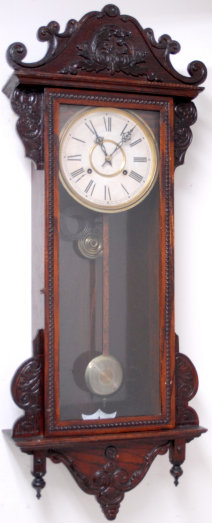
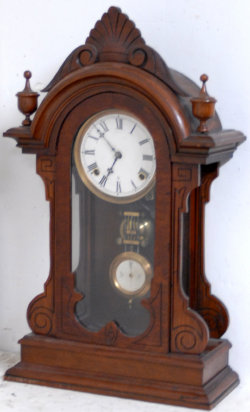
25. $350
“G. A. Jones & Co. New York”, 8-day mantel clock, “Egyptian”, in a large and attractive case, ca 1870-1874. This clock reminds me of several Ansonia clocks produced after 1877 when Ansonia was reorganized and Henry J. Davies became General Manager. Davies had bought out George Jones in 1874. In other words, Davies continued making the Jones models when he was in business for himself and also when he ran Ansonia. I am surprised Ansonia did not name a clock Egyptian. This walnut case is 24 ½ inches tall, the four clock sides are identical, it has 3 glasses, finials, and ornate top and a fancy pendulum that Jones was noted for. The paper dial is a replacement, and the clock deserves a nice painted dial. The 8-day movement is running and striking a bell on the hours. On the back is a complete paper label. $400-$600.
21. $1850
“Atkins Clock Co. / Bristol, Conn.”, “Parlor No. 1” case, with their “Type III”, 30-day wagon spring movement, ca 1852. The rosewood case is 17.5” high, 13” wide, and 5” deep. The case style was very unusual for its day with very detailed beveled front, top and base. The two doors have brass knobs and the bottom door has an original painted glass. The top glass has gold leaf with over painting. The painted metal dial has no flaking to speak of, except some small key chipping around the winding arbors. It has hands and an old brass pendulum bob but cannot be sure if they are original. The wagon spring frame is cast iron and has a decorative scroll design. On the backboard is a complete legible label. The screws holding the dial and the tablet, need some attention. Atkins was always experimenting and changed cases and movements on a whim. Reference: “The Clocks of Irenus Atkins”, by Gregory and King. Cases, movements, glasses, etc. are pictured and described. $1850-$2500.


26. $1200
E. O. Stennes, Weymouth, Mass. 8-day weight driven banjo, ca
about 1964. The 8-day movement is signed, “E. O. Stennis, Weymouth, Mass. #5”. Many of the movements used by Mr. Stennes were from
a large group of Howard No. 5 banjo clocks purchase from a school system. The “5” was already stamped; Mr. Stennes added his name
and address. The pendulum is also signed, “5”. The mahogany cross banded case is 33” high, numbered, “7-64” on the case. The pendulum
is the type used by Stennes in his banjo clocks, there is his trademark “bee” on the dial, hidden behind the bezel. That was a trademark
he customarily used on his dials. The dial and hands appear to be original to the case, good bright gold bezel with bowed glass, gold
side rails, unusual finial on top, and the original painted glasses. This clock normally sells for near $5000 at the auctions where
people fly in from everywhere, rent hotel rooms, and pay big fees to the internet companies that post the auctions on line. $1500-$2500.

27. $800
E. Howard, Boston, “Regulator No. 70”, ca 1880. Beautiful oak
case, clean, polished, and completely original. It is 32” high, has the original eight-day, time only movement that is signed and
running briskly. 12” painted dial is nearly perfect, maybe some slight fading of the Howard name on the dial. Good painted lower glass
has some minute paint chips. Both glasses are original and the doors have proper latches. There are a few small chips on the painted
glass and no attempt has been made to cover them. At some point you may want to reback the glass to hold the original paint. Correct
damascened pendulum bob and stick, pendulum tie down, weight baffle board, pulley, and a correct iron weight, all near perfect and
original to this case. The weight is marked and movement are marked “70”. Ly-American, page 123. $1000-$1500.
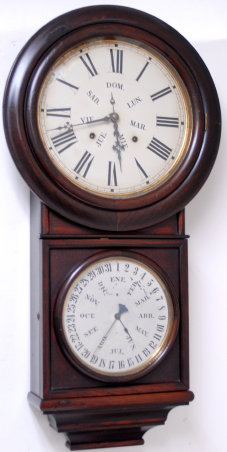
28. $450
“Welch, Spring & Co. No. 4 Round Head Calendar”, ca 1878.
The 8-day movement was made by the E. N. Welch Manufacturing Company and has a recoil escapement. It is spring driven, strikes hours
on a coil gong. The calendar mechanism on the back of the lower door has a complete label indicating it was made by B. B. Lewis. Normally
these cases would have one or two labels inside on the lower backboard. Because it was going to the Spanish market the labels were
left off and a black paper was installed to cover the backboard. The dials are original and are designed for the Spanish market. The
hands and pendulum are original to the clock. The 30-inch-high rosewood case is very nice to be 140 years old. This is a fine example
of this rare calendar model. Ly-Welch, page 74; Ly-Calendar #734. This clock has consistently booked and sold for over $1500. Well
it did until Washington declared that every American should own their own home. $500-$750.
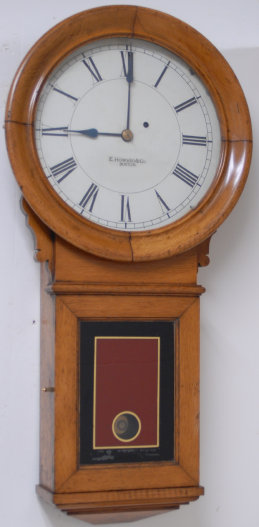

29. $450
Chelsea Clock Co. “No. 1 Pendulum”, office regulator in cherry,
ca 1911. We have a good looking 34” high quarter sawn oak case that looks to be all original and is complete. Correct door latches,
glasses are original, so is the brass pendulum, wood stick, and pendulum tie down. The 8-day time only movement is original to the
case and is signed. The iron weight is the correct type for this model clock. The dial pan is original and the dial was repainted
by The Dial House. If not for the repainted dial, this clock could sell in the $3000 range. Well, maybe a few years ago. It can sure
be improved but maybe not to the $3000 value. Ly-American, Volume 1, page 78. $500-$750.
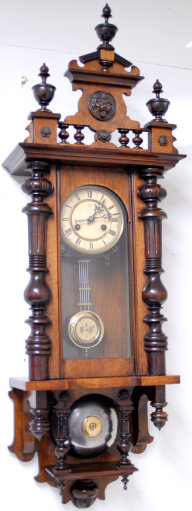
30. $750
Junghans, Germany, R A wall clock with unusually large bell on
the tail of the clock. I thought I had seen every imaginable creation of a clock until now. The nickel bell is about 6 inches in diameter.
A long wire from the movement pulls the bell strike each hour. The mahogany case is no slouch itself for it is 42 inches tall and
covered with finials, columns, and many applied ornaments. It has three glasses, removable top piece, and a very nice, typical, RA
pendulum. The 8-day movement is signed, running and striking the bell the number of hours as it should. $750-$1000.